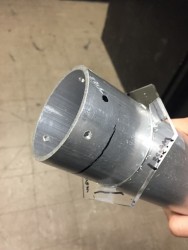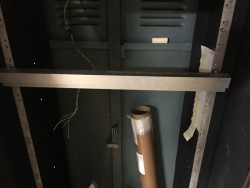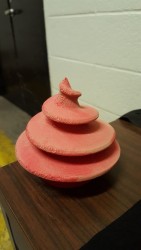Did you know that there’s a group of Columbia students travelling to NASA’s headquarters in Houston this spring? We didn’t either, until we heard about Columbia Space Initiative, CU’s newest space engineering club. Bwog writer Betsy Ladyzhets attended one of the group’s meetings and talked to them about their projects.
In case you hadn’t heard, one of NASA’s most recent projects involves collecting an asteroid. Yeah, that’s right – grabbing one of those huge chunks of rock floating around in space and pulling it out of orbit. The task sounds incredibly challenging; it involves somehow harnessing an asteroid in zero gravity, with an anchor that adheres to the rock’s surface despite the thick layer of sand that makes finding purchase difficult.
And yet, the students of the Columbia Space Initiative believe they can design such an anchor at Columbia this semester, with virtually no budget, while simultaneously taking full course loads. The Columbia Space Initiative (or CSI, for short) is a group of aspiring engineers interested in space. They take on challenges related to space engineering, posed by various companies (like NASA, but not limited to NASA) that want to get students involved in their work. The club is run by a student board comprised of leaders of the task-force teams for each of the group’s current challenges, but their faculty advisor (they’re very proud of this) is Professor Mike Massimino, Columbia’s astronaut in residence.
The club formed only a few months ago in September, 2015. A group of students interested in engineering and looking for hands-on experience outside of Formula SAE, Columbia’s only engineering club at the time, met at a lecture given by Prof. Massimino and discovered their common goals. They talked to each other, talked to Prof. Massimino, and then started applying to any and all space engineering-related challenges they could find. That group of students now comprises CSI’s board; the general body of the group is much bigger.
At CSI’s meeting last Thursday, I heard Kristina Andreyeva and Tamas Sarvary, both SEAS ’17 and the co-leaders of the asteroid anchor mission, explain more about their plan. The challenge calls for the group to have a finished, working product ready by the end of April, so that teams can travel to NASA’s Neutral Buoyancy Lab in Houston, Texas to test their designs. However, Kristina and Tamas want to have a prototype ready much sooner, to display at a conference at the Intrepid Sea, Air & Space Museum next weekend. Their design has been approved by NASA, and they’ve already procured many of the materials they need to put together a prototype, but the idea of actually building something worth looking at in about a week is daunting. But the two project leaders seemed undeterred, encouraging as many general body members as possible to come to build sessions and help out with planning.
After the meeting, I talked to Kristina for a few minutes about NASA’s asteroid challenge (or the Micro-g NExT challenge, as its official title goes). She explained to me that the main issue with anchoring an astronaut to an asteroid is that space has no gravity; anything the rock was hit with would just bounce back. CSI aims to solve this problem by inserting an anchor into the rock’s surface, with a claw that can extend into the rock and grab hold. They’ll find out how successful this plan is in the spring, when CSI travels to Houston to test their prototype. Kristina called this testing the most exciting part of the contest, since she and other students in her group will get to work with astronauts and NASA engineers.
“Building anything is always fun,” Kristina said, but she admitted that building a model is also challenging – especially when parts are expensive and your club has little funding. Since CSI isn’t an officially recognized CU club yet, they have to rely entirely on grants and outside sources for funding. “We’re trying everything,” Kristina said. A GoFundMe campaign is very likely in CSI’s future.
In the Micro-g NExT challenge, CSI is up against groups from twenty-four other schools, including Cornell, Purdue, Rochester Institute of Technology, and Virginia Polytechnic Institute. I asked Kristina what would happen if her group was victorious. CSI’s design would be looked at seriously, she told me, but there is no monetary prize.
“That’s why they get excited college kids for this,” she said. “NASA is outsourcing their problems to us, but we’ll happily do it for the glory.”
CSI’s most noteworthy current mission is NASA’s Micro-g NExT challenge, but it isn’t all they’re working on. Their other missions are: launching high altitude balloons to track via satellite and radio GPS, place a small satellite into orbit (which is actually possible if they obtain funding from CubeSat, another NASA challenge), design and build small-scale rockets, and design a mission for exploring Mars’ moons. This last project is particularly important to the group because, if CSI’s plan makes it past the challenge’s second round, they’ll get an all-expenses-paid trip to attend a forum in Cape Canaveral, Florida, as well as a monetary prize.
The club is also focused on outreach work, also known as “getting other people excited about space.” For the most part, outreach entails CSI going to conferences and schools and presenting their work. Representatives of the group (and, if all goes well, an asteroid anchor prototype) will be making appearances at the Intrepid conference, STEM Night at the New York Hall of Science, and Columbia Splash, a program in March that brings high school students to Columbia for a day of classes taught by Columbia students. At Intrepid, CSI is even bringing a set of Legos, so that kids who visit their table can build their own asteroid anchors. CSI is hoping to visit some high schools to share their work there as well. And, for the general public, the group wants to start a blog with posts on their missions, their ideas, thoughts about life and the universe in general, etc. As of Thursday’s meeting, possible titles for this blog include: “Astrolion,” “Spaceroar,” and “LionsFromOrion.”
The Columbia Space Initiative is a fairly new group on campus, but they’re already working with NASA, increasing space enthusiasm, and really anchoring themselves in the Columbia community. Their dedication to their projects is truly inspiring, albeit a little dangerous to their studies at times. “I failed a midterm to get the proposal together,” Kristina said of the first round of the Micro-g NExT challenge. “But it was worth it.”
- The body.
- What they have for the testing rig. “However it’s just a metal bar propped up to the closet.”
- A recently-printed cone
You can check the CSI out on their website, or on Twitter, Facebook, or Instagram. They’re getting pretty famous on Twitter, actually – NASA retweeted them once, and one time, they got followed by the guy who sang Chocolate Rain on YouTube. He unfollowed them a few hours later because they didn’t immediately follow him back, but they do have screenshots to prove it happened.
All photos via CSI


 5 Comments
5 Comments




5 Comments
@SEAS '17 Make us proud guys!
@engineer-wanna-be Good luck guys! Bring honor to us all.
@seas'17 Formula SAE is not the only other engineering club on campus, are you kidding? The biggest one by far is Engineers Without Borders, not to mention NSBE, SHPE, SWE, etc..
@Matt Cruse Wow, this group sounds so cool! SPAAAAAAAAAAAAAAAAAAACCCCCCCCCEEEEE
@seas '18 kid I can’t express how happy this article made me :) Y’all are doing such awesome work, keep it up!! Makes me even prouder to be a Columbia engineer~